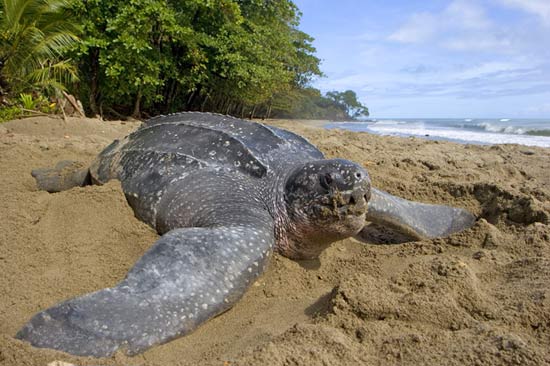Turtle Migrates 12,774 Miles

A leatherback turtle was tracked by satellite traveling 12,774 miles (20,558 kilometers) from Indonesia to Oregon, one of the longest recorded migrations of any vertebrate animal, scientists announced in a new report on sea turtle conservation.
Leatherback sea turtles (Dermochelys coriacea) are the largest of all living turtles and are widely distributed throughout the world's oceans. They have been seen in the waters off Argentina, Tasmania, Alaska and Nova Scotia.
Adult leatherbacks periodically migrate from their temperate foraging grounds to breeding grounds in the tropics.
Scientists at the National Marine Fisheries Service (NMFS) tracked one female nester, who was tagged on Jamursba-Medi beach in Papua, Indonesia, on her journey back to her foraging grounds off the coast of Oregon. She was tracked for 647 days covering a distance about equal to two round trips between New York and Los Angeles.
The turtle's trip set a new record for sea turtles, and is among the longest documented migrations for any marine vertebrate.
The longest measured annual migration for any animal is the 40,000-mile (64,000-kilometer) journey between New Zealand and the North Pacific of the sooty shearwater (Puffinus griseus), a medium-sized seabird.
The leatherback tracked by the NMFS belongs to one of two distinct breeding populations in the Pacific, the western group. Other research has shown that nesters from this population migrate through areas in the Philippines, South China Sea, Japan, and the waters around many other countries, spurring conservationists to call for an international effort to protect the species, which is listed as Critically Endangered on the World Conservation Union's Red List.
Sign up for the Live Science daily newsletter now
Get the world’s most fascinating discoveries delivered straight to your inbox.
The turtle's journey is featured in an article in the third annual volume of the State of the Worlds' Turtles Report, written by NMFS scientists Peter Dutton and Scott Benson and Creusa Hitipeuw of WWF-Indonesia.
- Top 10 Most Incredible Animal Journeys
- Beach Patrols Help Sea Turtles Rebound
- Do All Turtles Have Shells?

Andrea Thompson is an associate editor at Scientific American, where she covers sustainability, energy and the environment. Prior to that, she was a senior writer covering climate science at Climate Central and a reporter and editor at Live Science, where she primarily covered Earth science and the environment. She holds a graduate degree in science health and environmental reporting from New York University, as well as a bachelor of science and and masters of science in atmospheric chemistry from the Georgia Institute of Technology.










